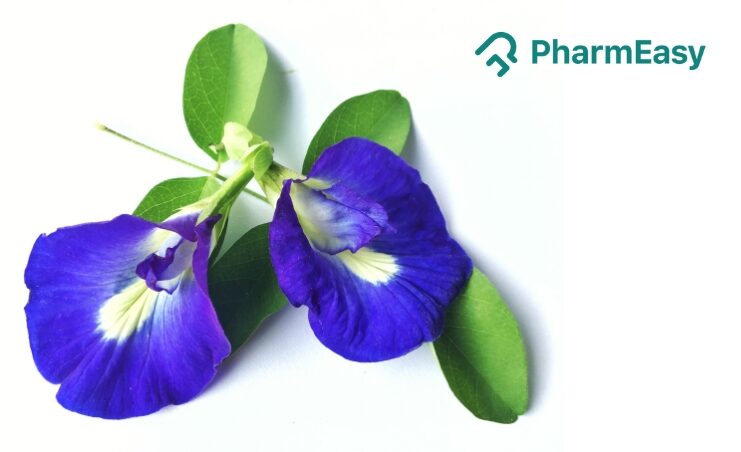Butterfly Pea Flower: Uses, Benefits, Side Effects & More!
By Dr Rajeev Singh +2 more

Get,

to manage your symptom
Get your,


4 Cr+ families
benefitted

OTP sent to 9988776655



You’ve successfully subscribed to receive
doctor-approved tips on
Whatsapp

Get ready to feel your best.

Hi There,
Download the PharmEasy App now!!


Register to Avail the Offer
Send OTPBy continuing, you agree with our Privacy Policy and Terms and Conditions

Hi There,
Sign up on PharmEasy now!!
Trusted by 4 crore+ families

OTP sent to 9988776655



You have unlocked 25% off on medicines




Code: NU25
By Dr Rajeev Singh +2 more
Table of Contents
The butterfly pea flower, scientifically known as Clitoria ternatea, is admired for its striking blue colour. It is used both as a herb and a natural dye. Even cosmetic enthusiasts find a use for it. It is said to contain a lot of antioxidants, which are probably responsible for its vibrant colour. Studies also propose that they have health-boosting properties1.
In this article, we’ll delve into the details about its potential health benefits. We’ll discuss the influence it has on skin, hair, weight, and blood sugar balance. Lastly, we will answer some frequently asked questions regarding this topic.

Did you know?
The butterfly pea flower is from Southeast Asia1. It’s been around in the food and medicine industry for years. Its deep blue flowers are very vibrant and beautiful.
When it meets varied pH levels, the flower shade changes. Imagine adding lemon juice to it. The blue tone will turn purple. It’s why cocktail makers and food artists use it to add an element of magic to their cocktails1.
It’s packed with antioxidants. Its ternatins alone make it beneficial. It also contains kaempferol, p-coumaric acid, and delphinidin-3,5-glucoside1,2,5,6,7.
It’s been a staple in Southeast Asia’s Ayurveda medicine. It’s a natural dye for textiles, foods, and hair procedures. It’s also served as a calming herbal tea with honey and lemon1.
It’s packed with antioxidants that may lend support to maintaining skin and hair health. Ternatins and their fellow antioxidants may offer other benefits8.
Antioxidants fight free radicals. So, these can protect your skin and hair from damage. By using butterfly pea flower products in skincare or haircare, you may be able to reap the benefits of its antioxidants9,10,11.
Inflamed skin and hair can lead to acne and hair loss12. The plant’s compounds could calm inflammation. That may result in healthier skin and hair2,4.
Butterfly pea flowers may help with weight loss. It may promote weight loss by blocking the synthesis of fat cells and slowing the formation of new ones13,14,15,16.
Drinking butterfly pea flower tea may aid digestion. That could help you make the most of food nutrients and calories. This might aid in weight control1.
Reports are suggesting that its extract might curb your appetite. Less appetite means fewer calories, thus culminating in weight loss. More research is needed to corroborate these benefits15,16.
The butterfly pea flower might help to keep blood sugar levels steady. Studies have shown that drinks with their extract lead to lower blood sugar and insulin levels. Plus, the plant’s antioxidants may guard against cell havoc related to diabetes17. More studies are required on this.
Early studies hint that butterfly pea flowers might boost cognitive health. Its antioxidants might guard against mental decay with age. There may be gains in memory, focus, and learning. More studies are needed to determine how butterfly pea flower impacts cognitive health1.
Its herbal tea is popular for its calming nature. There isn’t much research on this yet. If you’re dealing with anxiety and want to incorporate this herbal tea, it is better to consult your doctor first, they will assess your situation and its severity and advise accordingly1.
Its antioxidant content may help support the immune system too. They may protect your body from nasty free radicals. So, it is proposed to strengthen your immune response and boost overall health1.
The benefits of butterfly pea tea extend to our eyes! Anthocyanins, a group of antioxidants found in these flowers, have been demonstrated to potentially improve blood flow to the eyes. This might aid in glaucoma, retinal degeneration, impaired vision, and eye fatigue. Additionally, it has been demonstrated that it might improve night vision and shield the eyes from possible harm18.
Dr. Siddharth Gupta, B.A.M.S, M.D (Ayu)
Try honey, lemon juice, or mint leaves to enhance flavour. Lemon juice can turn your beverage from blue to purple.
In Southeast Asia, people use butterfly pea flowers for food colouring. So, adding it to your rice or noodles could give them a unique look and taste.
Your desserts and drinks will love its colour-changing properties. Get creative with it in simple syrups, cocktails, and baked sweets.
You can also use butterfly pea flowers as a natural food colouring. It can even dye fabrics. Use it instead of fake colours for an eco-friendly pick.
In addition to being consumed as tea or food, butterfly pea flowers are believed to offer amazing therapeutic properties when applied topically. It has been demonstrated in trials to boost skin hydration by 70% in just one hour after application. This may be because the flower has flavonoids, polyphenols, and antioxidants that might promote the body’s natural synthesis of collagen and elastin. Moreover, it possesses anti-glycation qualities that might delay skin ageing. These characteristics make the butterfly pea flower anti-inflammatory and potentially beneficial for addressing allergies, skin irritation, redness, and itching8.
Dr. Rajeev Singh, BAMS
In general, it’s safe in moderation. But some may face allergies. The symptoms may include itching, swelling, and trouble breathing. If you think you might be allergic to butterfly pea flowers, call your healthcare provider.
There’s not a lot of information on drug interactions. You should call your healthcare provider before using it if you’re on medication.
We need more research on its safety for pregnant or nursing women. As a safety measure, they should avoid using it unless advised by a healthcare provider.
Traditionally, people believe in managing respiratory ailments with the butterfly pea flower. It is believed that the butterfly pea flower may lower inflammation of the lungs and other respiratory organs due to its anti-inflammatory qualities. It may also aid in the removal of excess fluid accumulation, which makes it a potentially great remedy for coughs and colds. According to a 2018 study, butterfly pea tea has these qualities and may be regarded as useful for the management of allergies and asthma19.
Dr. Smita Barode, B.A.M.S, M.S.
The butterfly pea flower is a plant from Southeast Asia. It offers a bounty of potential health benefits. Its antioxidants may serve your skin and hair, aid weight loss, and balance blood sugar. You can use it in teas, as a colouring in cooking, and even in dyes.
Always consult your healthcare provider before incorporating butterfly pea flowers into your diet or skincare regimen. Do this especially if you have allergies, take medications, or are pregnant or breastfeeding.
Also Read: Punarnava: Uses, Benefits, Side Effects & More
Its taste is mild and earthy. It resembles green tea. You can enjoy it alone or with honey, lemon, or mint.
Yes, in general, it is safe when eaten in moderation. Always ask your healthcare provider before using butterfly pea flowers. Also, if you’re prone to allergies, pregnant, or breastfeeding, then it is better to avoid.
People allergic to the flower should not drink the tea. Pregnant and breastfeeding women should avoid it. Always consult your healthcare provider.
No exact daily amount is set yet. Most people can safely enjoy one or two cups per day. If you have any health issues, discuss with your healthcare provider first.
Disclaimer: The information provided here is for educational/awareness purposes only and is not intended to be a substitute for medical treatment by a healthcare professional and should not be relied upon to diagnose or treat any medical condition. The reader should consult a registered medical practitioner to determine the appropriateness of the information and before consuming any medication. PharmEasy does not provide any guarantee or warranty (express or implied) regarding the accuracy, adequacy, completeness, legality, reliability or usefulness of the information; and disclaims any liability arising thereof.
Comments

Leave your comment...
You may also like
Comments